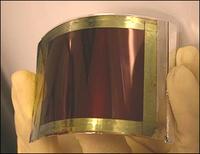Korea Develops Futuristic Solar Cell
Seoul July 20, 2005; Kim Tae-gyu writing for the Korea Times reported that South Korean scientists have developed a next-generation solar cell, which is the best fit for such futuristic products as wearable computers thanks to its high efficiency and flexibility.
The state-backed Electronics and Telecommunications Research Institute (ETRI) Wednesday said its researchers created a flexible dye-sensitized solar cell.
``In the future, people will carry flexible solar cells in their neckties or clothes to power wearable computers or cell phones. Our items are suitable for those applications,’’ ETRI researcher Ryu Kwang-sam said.
The ETRI used a sheet of plastic on the front of the dye-sensitized cell and a sheet of stainless steel behind for flexibility and energy efficiency.
The dye-sensitized solar cell, a new attempt compared to current silicon-based solar cell inside handheld calculators or satellites, uses an organic dye to absorb light, which is converted to electricity.
Its main advantage is cost effectiveness as the cell costs up to 80 percent less to manufacture than traditional silicon-using cells.
The dye-sensitized cell, sometimes called a third-generation solar cell, also has a competitive edge in that it is transparent and can be developed in various colors.
However, the cell typically made of glasses does not bend, limiting its applications. Nations like Korea and Japan have been competing to develop flexible dye-based cells.
``Scientists have depended on plastics to make flexible dye-based solar cells but the hitch was that its energy efficiency of converting the light into electricity was as low as 2 percent,’’ Ryu said.
By contrast, the ETRI confirmed through laboratory tests energy conversion rate more than doubled to 4.8 percent in its new models using plastic plates and stainless steel sheets.
``In comparison to silicon solar cells, our dye-based cell has about double the cost effectiveness in making the same amount of electricity,’’ Ryu said.
The ETRI already applied international patents for their findings to six countries including the United States and Japan. The agency plans to start talks with domestic companies to commercialize the technology late this year.
Overall, the market of solar cells is expected to reach $4 billion in 2006 and as much as $10 billion by 2010 according to Business Communications Company, an international consultancy.
Ryu projected the market would further expand if the current trend of high crude oil prices continue and flexible solar cells would carve out a large portion of the pie since it has mobility-friendly applications.



